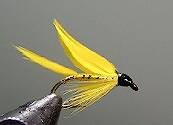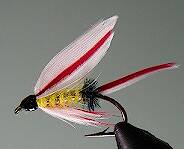
Hex Mayflies
Hexagenia limbata
The famous nocturnal Hex hatch of the Midwest (and a few other lucky locations) stirs to the surface mythically large brown trout that only touch streamers for the rest of the year.
Featured on the forum

This is an interesting one. Following the keys in Merritt R.W., Cummins, K.W., and Berg, M.B. (2019) and Jacobus et al. (2014), it keys clearly to Ephemerella. Jacobus et al provide a key to species, but some of the characteristics are tricky to interpret without illustrations. If I didn't make any mistakes, this one keys to Ephemerella mucronata, which has not previously been reported any closer to here than Montana and Alberta. The main character seems to fit well: "Abdominal terga with prominent, paired, subparallel, spiculate ridges." Several illustrations or descriptions of this holarctic species from the US and Europe seem to match, including the body length, tarsal claws and denticles, labial palp, and gill shapes. These sources include including Richard Allen's original description of this species in North America under the now-defunct name E. moffatae in Allen RK (1977) and the figures in this description of the species in Italy.

Troutnut is a project started in 2003 by salmonid ecologist Jason "Troutnut" Neuswanger to help anglers and
fly tyers unabashedly embrace the entomological side of the sport. Learn more about Troutnut or
support the project for an enhanced experience here.
Martinlf on Apr 20, 2009April 20th, 2009, 2:05 pm EDT
Hi,
Two folks (you know who you are) have asked me about a CDC caddis tie, so here's how I do mine. They worked this weekend on Grannoms.
This caddis is easy to tie with a little practice, and it has taken some very picky, hard-pressured fish. I give a lot of detail in the directions that many will not need, but if you’ve never worked with CDC it may save you some headaches.
Tie in a short sparse antron or z-lon shuck, dub the body with an appropriate color for the abdomen (see below for Grannoms). Leave an eye length or two of the hook bare just behind the eye for tying in the CDC. Select three or four CDC feathers, hold each by the tip and stroke the fibers out perpendicular to the shaft, then stack them on top of each other, keeping the curves of the feathers the same so they will nest right on top of each other. Then holding the feather ends with left thumb and forefinger, strip off fibers on one side with the right thumb and forefinger. Next find a way to turn the feathers over in your left hand, keeping them stacked and lined up. (Holding the stripped fibers between thumb and index finger, I make a Star Trek Vulcan split between the ring and index finger of my right hand, flip my left wrist over to flip over the feathers, slip the body end of the feather shaft in the split between my ring and index fingers, clamp down, and let go with my left thumb and forefinger. Then I turn my left hand over to regrasp the stacked feathers which are now upside down and in the same position the feather barbs were when I did the first strip.) Then, carefully raise the right thumb, making sure the stripped fibers stay down on the right forefinger with gravity’s help. Move your left hand to lay the fibers on the unstripped stack right down on the stripped fibers, tips to tips, butts to butts, with the shaft of the feathers right over the stripped butts. The better the butts line up from the stripped and unstripped barbs makes all the difference. Grasp the tips of all the fibers with your right thumb and forefinger and strip CDC fibers off the other side of the stacked feathers. Roll the thumb and forefinger of the right hand away from the butts of the stripped fibers and grasp the butts with the left thumb and forefinger to gather them together. This takes some practice, and results in a few messes before you develop a way of doing it, but you should ideally end up with a nice bunch of CDC, with butts all together. Repeat the rolling motion several times to work the fibers into a “paintbrush” of CDC with all the butts together. Then pinch tie this bunch, butts forward over the eye, tying down just behind the eye with a couple of turns of thread. Then lift the butts and lay down some wraps back right against the first couple of tie down wraps to bind the wing in tightly sandwiching it between the initial wraps over it and the next ones under coming back. Next, whip finish under the wing butt fibers just behind the eye and trim the butts to expose the hook eye. Cut carefully to avoid cutting the thread. A tiny drop of superglue on the butts makes the fly bombproof, though I rarely use it except when tying flies for other folks. (I should note that I had several wings pull out with hard use this weekend, and am rethinking this. I'll probably start supergluing all mine--but a tiny tiny micro drop, or you'll mess up the CDC.) Then angle your scissors to cut the CDC tips forming the end of the wing at a slant, to imitate a caddis wing shape, cutting the wing about even with the end of the shuck, leaving the wing a bit longer than the hook.
For Grannoms, I sometimes skip the shuck, sometimes add a thread rib, and use dark grey, black, or brown dubbing (I fished flies with each last season, and it didn’t seem to make a difference. I tied some flies at my brother-in-laws and used his black ice dubbing blended with a little black fur or superfine (can’t remember which) and these seemed to work. Last time I tied Grannoms I used dark grey dubbing, with a black thread rib, then dark brown squirrel for a spiky thorax, tying the flies on a Tiemco 101. I used a bit of high viz for the shuck, so it would actually blend with the wing to help give the wing a bit of sparkle. You could use a sparse bunch of CDC for this also. Or you can omit the shuck.
Most if not all of you will know this, but just in case: Don’t use standard floatants with CDC. They will mat and ruin the feathers. I prefer Frog’s Fanny, but Harrop’s CDC floatant, and some silicone floatants like the old Simms pen style silicone floatant are OK. Some people like Tiemco’s dry magic for CDC. First squeeze all the water out of the fly with a tanned deerskin patch, chamois, amadou, samadou, or other dry absorbent material. Blow to fluff out, then apply floatant. With Frog’s Fanny you can revive the fly many times this way. When you can no longer get it to float, replace it and let it dry thoroughly.
Two folks (you know who you are) have asked me about a CDC caddis tie, so here's how I do mine. They worked this weekend on Grannoms.
This caddis is easy to tie with a little practice, and it has taken some very picky, hard-pressured fish. I give a lot of detail in the directions that many will not need, but if you’ve never worked with CDC it may save you some headaches.
Tie in a short sparse antron or z-lon shuck, dub the body with an appropriate color for the abdomen (see below for Grannoms). Leave an eye length or two of the hook bare just behind the eye for tying in the CDC. Select three or four CDC feathers, hold each by the tip and stroke the fibers out perpendicular to the shaft, then stack them on top of each other, keeping the curves of the feathers the same so they will nest right on top of each other. Then holding the feather ends with left thumb and forefinger, strip off fibers on one side with the right thumb and forefinger. Next find a way to turn the feathers over in your left hand, keeping them stacked and lined up. (Holding the stripped fibers between thumb and index finger, I make a Star Trek Vulcan split between the ring and index finger of my right hand, flip my left wrist over to flip over the feathers, slip the body end of the feather shaft in the split between my ring and index fingers, clamp down, and let go with my left thumb and forefinger. Then I turn my left hand over to regrasp the stacked feathers which are now upside down and in the same position the feather barbs were when I did the first strip.) Then, carefully raise the right thumb, making sure the stripped fibers stay down on the right forefinger with gravity’s help. Move your left hand to lay the fibers on the unstripped stack right down on the stripped fibers, tips to tips, butts to butts, with the shaft of the feathers right over the stripped butts. The better the butts line up from the stripped and unstripped barbs makes all the difference. Grasp the tips of all the fibers with your right thumb and forefinger and strip CDC fibers off the other side of the stacked feathers. Roll the thumb and forefinger of the right hand away from the butts of the stripped fibers and grasp the butts with the left thumb and forefinger to gather them together. This takes some practice, and results in a few messes before you develop a way of doing it, but you should ideally end up with a nice bunch of CDC, with butts all together. Repeat the rolling motion several times to work the fibers into a “paintbrush” of CDC with all the butts together. Then pinch tie this bunch, butts forward over the eye, tying down just behind the eye with a couple of turns of thread. Then lift the butts and lay down some wraps back right against the first couple of tie down wraps to bind the wing in tightly sandwiching it between the initial wraps over it and the next ones under coming back. Next, whip finish under the wing butt fibers just behind the eye and trim the butts to expose the hook eye. Cut carefully to avoid cutting the thread. A tiny drop of superglue on the butts makes the fly bombproof, though I rarely use it except when tying flies for other folks. (I should note that I had several wings pull out with hard use this weekend, and am rethinking this. I'll probably start supergluing all mine--but a tiny tiny micro drop, or you'll mess up the CDC.) Then angle your scissors to cut the CDC tips forming the end of the wing at a slant, to imitate a caddis wing shape, cutting the wing about even with the end of the shuck, leaving the wing a bit longer than the hook.
For Grannoms, I sometimes skip the shuck, sometimes add a thread rib, and use dark grey, black, or brown dubbing (I fished flies with each last season, and it didn’t seem to make a difference. I tied some flies at my brother-in-laws and used his black ice dubbing blended with a little black fur or superfine (can’t remember which) and these seemed to work. Last time I tied Grannoms I used dark grey dubbing, with a black thread rib, then dark brown squirrel for a spiky thorax, tying the flies on a Tiemco 101. I used a bit of high viz for the shuck, so it would actually blend with the wing to help give the wing a bit of sparkle. You could use a sparse bunch of CDC for this also. Or you can omit the shuck.
Most if not all of you will know this, but just in case: Don’t use standard floatants with CDC. They will mat and ruin the feathers. I prefer Frog’s Fanny, but Harrop’s CDC floatant, and some silicone floatants like the old Simms pen style silicone floatant are OK. Some people like Tiemco’s dry magic for CDC. First squeeze all the water out of the fly with a tanned deerskin patch, chamois, amadou, samadou, or other dry absorbent material. Blow to fluff out, then apply floatant. With Frog’s Fanny you can revive the fly many times this way. When you can no longer get it to float, replace it and let it dry thoroughly.
"He spread them a yard and a half. 'And every one that got away is this big.'"
--Fred Chappell
--Fred Chappell
Quick Reply
Related Discussions
Topic
Replies
Last Reply
3
Jan 16, 2007
by Martinlf
by Martinlf




